RENEGADE GARDENER™
The lone voice of horticultural reason
The 2013 Renegade Gardener High Spot / Black Spot Awards
1-1-14 – Severe, abominably cold New Year’s greetings to you all! Live from the basement employee cafeteria of the Hormel Corporation International headquarters in Austin, Minnesota, it’s the fourteenth annual Renegade Gardener High Spot/Black Spot Awards!
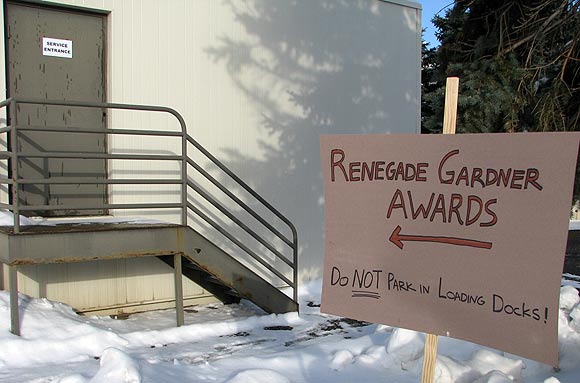
Before we take one single step toward greatness this evening, I would like to convey my sincere thanks to the fine people at Hormel for their gracious sponsorship of this year’s awards ceremony. For those of you just arriving, you missed the bacon-wrapped ham steak, bacon-wrapped pork loin, and bacon-wrapped bacon appetizers, but if you all will please be seated, waiters will commence serving this year’s theme dinner, “50 Shades of Spam,” a regrettably lengthy culinary romp highlighting the implausible evolution of America’s most infamous food product, invented right here in Austin.
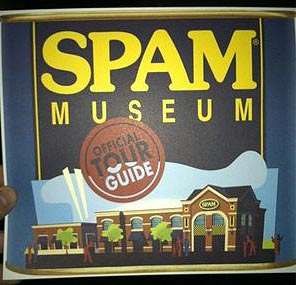
Following the awards all are invited to the fabulous post-award gala, a private group tour of the world famous Spam Museum, located one mile away in downtown Austin. Are we ready? Let’s give out some awards!
High Spot Award
Best Horticultural Sleight of Hand: Disguising Cell Towers as Trees

This year’s panel of judges – I’ll introduce them later on – reviewed photos of faux fauna-festooned cell towers submitted by Renegade Gardeners around the globe, and came to an unanimous decision: We love ‘em! Cell towers dot the landscape from Siberia to Sydney, and Tierra del Fuego to the Yukon Territories. They’re a necessary evil, like Google, and our snap decision was, if cell towers are going to stick out like sore thumbs, it’s preferable that they be elaborately bandaged.
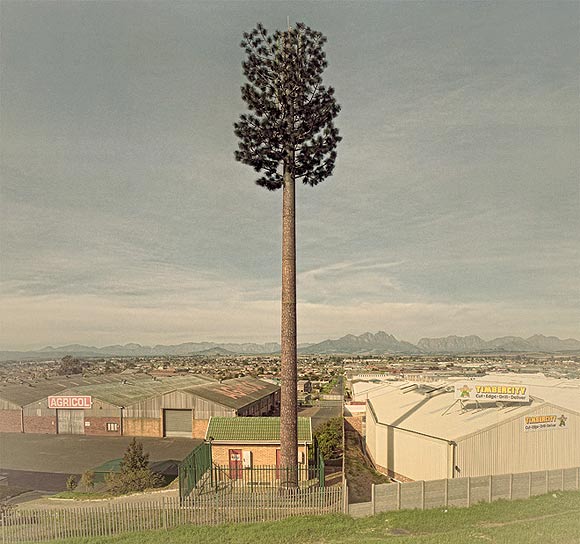
Sure there’s a downside – similar to concrete products masquerading as stone, you can spot ‘em a mile away, particularly during cloudy, gray days, when a standard cell tower far in the distance might escape notice. And sure, they look dreadful, but traditional steel cell towers don’t? Having a humorous approach to life, laughing aloud a few times each day, have been proven in clinical studies to lead to better health and increased longevity in humans. No one chuckles when spotting a giant steel cell tower (some curse), but feast your eyes on an eighty-foot pole rendered into an improperly pruned tree from another planet via some MIT geek’s perception of nature, and it’s hilarious.
Black Spot Award
Most Aesthetically Unpleasant Tree Circles
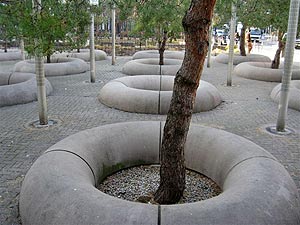 “If you don’t know how to pronounce a word, say it loud!” admonishes Oliver Strunk in his essential book (with E.B. White) on grammar and word usage, The Elements of Style.
“If you don’t know how to pronounce a word, say it loud!” admonishes Oliver Strunk in his essential book (with E.B. White) on grammar and word usage, The Elements of Style.
Unfortunately, the general principle – if lacking knowledge, go large – does not apply to landscape design. Thanks to Heather Lynn, the Canadian Renegade Gardener who submitted this photo of a park in Toronto, Ontario, possibly the most forlorn urban green space ever to come to the judge’s attention. It’s difficult to create a scene with trees that is wholly bereft of nature, though tree circles will always give you a head start toward that goal. Make the tree circles gigantic, out of poured concrete, and you accelerate past the finish line.
The sad thing is not that one of the trees died; the sad thing is that some cling to life. In a few years, when the rest are dead, at least the entire thing can be bulldozed, and fresh grant money awarded to a new landscape “artist,” preferably one who managed to escape the clutches of post-World War II minimalism.
High Spot Award
Deciduous Shrub of the Year: Hydrangea ‘Twist-n-Shout’
(Hydrangea macrophylla ‘PIIHM-I’ (PPAF)
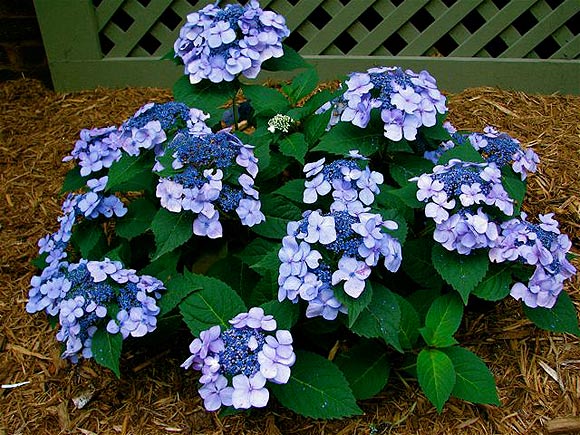
It took me several decades to come around to Hydrangeas, due certainly to the fact that great, gangly fortresses of ‘Annabelle’ haunt me from childhood, this drunken, loutish, cartoon of a shrub with its impossibly large pompoms of sinister, extraterrestrial white blooms.
Adding to my lack of interest over the years was the simple fact that many of the more fetching species of Hydrangea, H. quercifolia (Oakleaf) for one, were not hardy to my USDA Zone 4 growing range. On my trips to the Pacific Northwest, I would encounter fabulous, large, exquisite Oakleaf Hydrangea specimens flouting cone clusters of delicate flowers ranging from red to salmon to pink to blue to white, in proper proportion to the overall plant. In addition, many Hydrangeas in these cheater zones would display splendid fall foliage color versus northern species Hydrangeas, which typically sport leaves that in the fall turn brown, curl up, and drop. Zone envy is a poor precursor to plant appreciation.
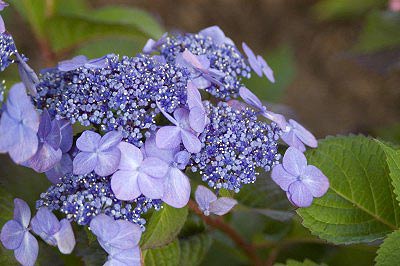 Then there’s Twist-n-Shout. It was developed by Bailey Nurseries, headquartered in St. Paul, Minnesota, the newest addition to their “Endless Summer®” line. It’s species macrophylla (large-leaved), one of the stalwart northern zone Hydrangea species not afflicted with the aforementioned pompom bloom type found in H. arborescens (‘Annabelle,’ for instance).
Then there’s Twist-n-Shout. It was developed by Bailey Nurseries, headquartered in St. Paul, Minnesota, the newest addition to their “Endless Summer®” line. It’s species macrophylla (large-leaved), one of the stalwart northern zone Hydrangea species not afflicted with the aforementioned pompom bloom type found in H. arborescens (‘Annabelle,’ for instance).
Meaning there is some sense of proportion to the thing. Bloom clusters are semi-flat, and whereas in full bloom in the right conditions plants are covered with flowers, it’s a very pleasing sight. The mid-green leaves are large, the stems are red, so you have something going on besides the flowers. Bloom color ranges from periwinkle blue to pink, depending on soil pH. In my experience, plants bloom a fabulous blue the first year – they’re grown and potted up in acidic soil – and remain blue in future seasons if the soil in your garden is only slightly acidic.
Blooming on new and old wood, you get a tremendous show of flowers, attractive foliage and kempt plant form pretty much through the entire growing season. Also, plants display a burgundy-red foliage color in fall, one of the few large-leaved Hydrangeas to do so.
 |
| Fall foliage |
It’s a mid-sized Hydrangea, growing 3-5’ tall with a spread around 3-4’. I’ve seen it used to wonderful effect in large containers. A word of caution, some sites already are listing the plant as Full Sun, and that’s a mistake. Plant ‘Twist-n-Shout’ in soil rich in organic matter, fertilize once in spring, water plants regularly, but keep it away from full sun, particularly several hours of direct, early afternoon sun, or it wilts. Half-day sun, early then late sun, light shade, dappled shade, all are good. USDA Zones 4-9.
Black Spot Award
Biggest Bummer: Jeff Gillman Leaves The University of Minnesota
 The North Star State lost a good one when consumer horticulture researcher, author, and Associate Professor at the University of Minnesota, Jeff Gillman, resigned after 15 years and headed for warmer climes. Jeff was not just a friend but teacher, whose scientifically accurate, common sense approach to plants and gardening were great assets to me, to students at the U of MN, and the community.
The North Star State lost a good one when consumer horticulture researcher, author, and Associate Professor at the University of Minnesota, Jeff Gillman, resigned after 15 years and headed for warmer climes. Jeff was not just a friend but teacher, whose scientifically accurate, common sense approach to plants and gardening were great assets to me, to students at the U of MN, and the community.
The two greatest factors in human existence that one can do nothing about – weather and university politics – played roles in Jeff’s decision to move to warmer climes and simpler times. He now lives with wife and family in Charlotte, North Carolina, where he is a far less-harried instructor at Central Piedmont Community College.
His books (facts only, please) are great, and I highly recommend them:
- How Trees Die
- How The Government Got In Your Back Yard (with Eric Heberlig, UNC)
- The Truth About Garden Remedies
- The Truth About Organic Gardening
- Decoding Gardening Advice (with Meleah Maynard)
All are available at Amazon, though Jeff always likes to steer people to Powell’s Books
Fairwell, Dr. Gillman! Although I’ll give you advance warning: I’m speaking in Charlotte, February 21-23. You fly, I’ll buy.
Black Spot Award
Most Moronic Ad Campaign: Toys R Us Attacks “The Forest”
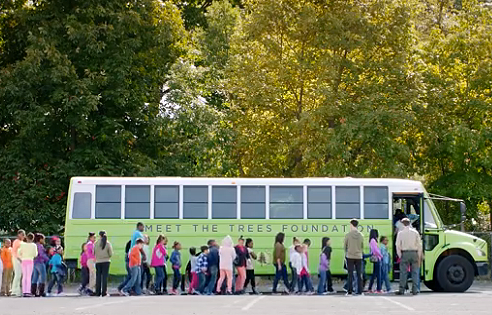 Let’s see, you’re a young hotshot advertising professional working for the big-time ad agency that includes the multi-million-dollar Toys R Us account as among their top clients. Time to pitch ideas to them for their always-crucial Christmas season TV ad campaign. How about one of those clever “reality prank” ads currently in vogue, where the people in the ad are told one thing, then you film their reaction when they discover the truth? Makes for such captivating television in those Febreze air freshener ads, when the blindfolds come off and a handful of people discover the spring meadow they think they’ve been walking through is actually an open sewage treatment plant just outside Bhopal, India.
Let’s see, you’re a young hotshot advertising professional working for the big-time ad agency that includes the multi-million-dollar Toys R Us account as among their top clients. Time to pitch ideas to them for their always-crucial Christmas season TV ad campaign. How about one of those clever “reality prank” ads currently in vogue, where the people in the ad are told one thing, then you film their reaction when they discover the truth? Makes for such captivating television in those Febreze air freshener ads, when the blindfolds come off and a handful of people discover the spring meadow they think they’ve been walking through is actually an open sewage treatment plant just outside Bhopal, India.
Here’s the winning idea: We’ll load a group of inner-city elementary students onto a bus, and have an actor posing as the tree nerd, “Ranger Brad,” tell them that instead of slogging through another boring day at school, the bus is taking them on a field trip to…the forest! We’ll paint a school bus green, see, and seal the hoax by painting “Meet The Trees Foundation” in bold type along the side. Once the bus takes off, the actor will engage the kids in boring nature-related games, such as holding up large drawings and asking them to “Name That Leaf.” We’ll edit in close-up shots of kids yawning, falling asleep, etc.
Now, here’s the great part: We’ll only torture the kids for a few miles by making them think they are going to be forced to spend the day in the forest, learning about nature, before “Ranger Brad” tears off his green ranger shirt to reveal his Toys R Us Team Member shirt. At which point he’ll tell the kids, “We’re not going to the forest today…we’re going to Toys R Us!” Joyous bedlam will break out on board, as the kids discover that instead of being sentenced to a day outside exploring the wonders of nature, they’ll be spending the day indoors engaged in a free shopping spree at Toys R Us.

No one is stupid enough to pitch, let alone develop, such an ad, you say? Actually, the above is exactly what happened, resulting in the creation of what may be the briefest Christmas television ad campaign ever engaged in by a major corporation. Toys R Us would have had a better chance at flying under today’s PC radar with a television ad making fun of Christianity, than slighting Mother Nature. The backlash over the ad was immediate and comprehensive.
The World Wildlife Fund, National Recreation and Park Association, North American Association for Environmental Education and additional nature and education groups immediately fired off open letters and press releases denouncing the anti-nature, pro-materialism theme in the ad. The November issue of Forbes magazine reported on the amazing degree with which the ad was backfiring with woman, including quotes such as, “This ad makes me weep for the kind of values we are passing down to future generations.” A Facebook campaign circulated a petition asking for 10,000 signatures from people objecting to the ad, to be presented to Toys R Us executives. I signed it and reposted. The goal of 10,000 signatures was reached in a week.
The TV ad, needless to say, was pulled from the airwaves soon after. Good work. This dear old, lumbering, semi-dysfunctional country of ours can still rise up and wield a quick and savage sword when the need arises.
If you didn’t see the ad – and you didn’t – you can view it by clicking here.
Stephen Colbert’s hilarious Colbert Report editorial on the incident can be viewed by clicking here.
High Spot Award
Perennial of the Year: Aralia cordata ‘Sun King’
Common Name: Spikenard
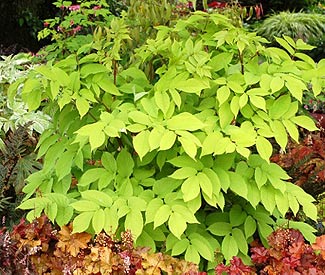 My fellow judges and I are suckers for perennials that grow to resemble mid-size shrubs. Particularly perennial-faux-shrubs offering large compound, golden leaves and an overall tropical appearance. Now add additional qualities such as two-foot tall racemes sporting globe-shaped clusters of white flowers, and that the plant thrives in part sun/medium shade, and you have the Renegade Gardener 2013 Perennial of the Year.
My fellow judges and I are suckers for perennials that grow to resemble mid-size shrubs. Particularly perennial-faux-shrubs offering large compound, golden leaves and an overall tropical appearance. Now add additional qualities such as two-foot tall racemes sporting globe-shaped clusters of white flowers, and that the plant thrives in part sun/medium shade, and you have the Renegade Gardener 2013 Perennial of the Year.
When gardening in shade, plant form and foliage color take on added importance, since you don’t have the surfeit of bloom color available from full sun plants. The sheer size of the plant – each compound leaf can measure upwards to three feet long – combined with the golden color of the foliage makes for eye-catching magic in those tricky, less-than-sunny spots. Use it to break up the monotony of lower-growing hosta, polemonium, pulmonaria, dwarf ferns and shade groundcovers.
‘Sun King’ is a breeze to grow; half-day sun to dappled shade will suffice. If the foliage starts heading toward chartreuse or into light green territory, move plants to a spot a notch or two down in light intensity, it’s called gardening. A great spot for hosta is a great spot for ‘Sun King.’ Plants prefer a good, deep loam, soil that will drain while remaining high in organic matter. You know – woodland soil.
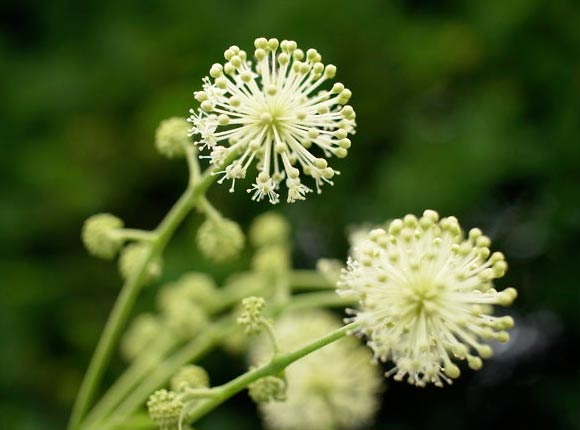
Flowers appear in mid- to late summer, small clusters of white that are not without interest, particularly to honeybees. Flowering is followed by purple-black, inedible berries. Put this perennial on your deer-resistant list, as deer do not often cause harm.
In proper culture, plants can reach five feet in height with an equal, glorious spread, though typically mature somewhat smaller. Divide, in spring, as you would any perennial. ‘Sun King’ is hardy to USDA Zone 3, with a growing range of zones 3-9.
An interesting side-note from Dan Heims over at Terra Nova Nurseries in Oregon: ‘Sun King’ was spotted by plantsman Barry Yinger at a department store in Tokyo. Barry brought it back with him to the US, where Terra Nova was the first to propagate it by tissue culture. Well done. Elegant without becoming brutish, Aralia cordata ‘Sun King’ is a most worthy, non-invasive addition to your landscape.
Black Spot Award
Worst Garden Reporting: Cornell Chronicle
![]()
An otherwise interesting article by a Cornell communications department reporter about the Ithaca, New York college’s tomato breeding program in the May 9, 2013 issue of the Cornell Chronicle was rendered incomprehensible by a single sentence representing the utter ignorance of many news reporters in the media, including, apparently, journalism graduates from Ivy League colleges.
It’s a fascinating story: Professor Martha Mutschler-Chu, a vegetable breeder and geneticist at Cornell’s College of Agriculture and Life Sciences, is performing amazing work with tomatoes, developing new varieties that deter pests and viruses. As reported in the article, “The dual resistant insect and virus varieties may reduce or even eliminate the need for pesticides in several regions.”
The reporter goes on to tell the history of Mutschler-Chu’s promising work, from the discovery of a single plant in Peru that exhibited novel insect resistance, to transferring the resistance into other tomato varieties, “and breeding out undesirable traits.” The reporter goes on to note, “After successfully transferring the resistance into new lines, (Mutschler-Chu’s) team added a second layer of protection: one or both of two natural genes known to resist the so-called TOSPO viruses, which include tomato spotted wilt virus.”
 Terrific stuff, hopefully leading to new tomato varieties that are resistant to thrips in addition to myriad viruses constantly being concocted by Mother Nature. Potential benefits of such a tomato are dutifully reported, such as a tomato crop, “that can be used commercially to essentially eliminate the need for pesticides. Not only would it be a boon to the U.S. agricultural economy, it could have significant impact in the developing world, where tomatoes are one of the most popular vegetable cash crops, especially for small subsistence farmers.”
Terrific stuff, hopefully leading to new tomato varieties that are resistant to thrips in addition to myriad viruses constantly being concocted by Mother Nature. Potential benefits of such a tomato are dutifully reported, such as a tomato crop, “that can be used commercially to essentially eliminate the need for pesticides. Not only would it be a boon to the U.S. agricultural economy, it could have significant impact in the developing world, where tomatoes are one of the most popular vegetable cash crops, especially for small subsistence farmers.”
All true, except for this astonishing sentence penned by the reporter midway through the article:
“The process does not require genetic modification and is completely safe.”
So here’s a reporter touting, in fairly astute detail, the genetic modification process at Cornell that could lead to a spiffy new, pesticide-reducing, hunger-abating, economy-helping GMO tomato, and doesn’t understand that it’s a GMO tomato. How could this be? Is she assuming that Cornell could not possibly be involved in such witchcraft? Or, is it that because the work involves simple cross-pollination (since the 1940s, the most common process used in the creation of GMO grain crops), she doesn’t recognize that everything she describes is genetic modification?
 Can’t be sure, but there also could be genetic engineering taking place in Mutschler-Chu’s work, sounds like it, so maybe that’s the answer. Ninety-five percent of the media reporting on food science (and ninety-nine percent of the public) don’t understand that whereas all genetically engineered crops are genetically modified organisms, not all genetically modified organisms are genetically engineered. Genetic engineering (GE) involves transferring genes between organisms that are not sexually compatible, by using recombinant DNA techniques. This creates a genetically modified organism (GMO). But you can also create a genetically modified organism by simple cross-pollination (sex). The resulting GMO is not GE.
Can’t be sure, but there also could be genetic engineering taking place in Mutschler-Chu’s work, sounds like it, so maybe that’s the answer. Ninety-five percent of the media reporting on food science (and ninety-nine percent of the public) don’t understand that whereas all genetically engineered crops are genetically modified organisms, not all genetically modified organisms are genetically engineered. Genetic engineering (GE) involves transferring genes between organisms that are not sexually compatible, by using recombinant DNA techniques. This creates a genetically modified organism (GMO). But you can also create a genetically modified organism by simple cross-pollination (sex). The resulting GMO is not GE.
(Incidentally, the above is based on the scientific definition according to the USDA, and is the accepted definition by a majority in the scientific field. You will, however, encounter dozens of websites with impressive sounding names, such as “Institute for Responsible Technology,” that blur the distinction and state that GE and GMO are one and the same. The Wikipedia page on “Genetically Modified Organism” gets it wrong in the first sentence, as does nongmoshoppingguide.com. Do not be fooled.)
So if Mutschler-Chu is NOT incorporating genetic engineering techniques into her work, and mentioned this to the reporter, the reporter believed the new tomato is not a GMO, which is of course, ridiculous.
Regardless, even though the second half of her statement is accurate – the new tomato, similar to GMO tomatoes created via cross-pollination by botanists and garden hobbyists dating back to at least 1870, is completely safe – the judges are forced to award the writer an “F.”
FYI, if you’d like to goof around along with thousands of your fellow gardeners across the globe and create your own, private label GMO tomatoes, here’s a good YouTube video on how to do exactly that (although careful, you have to pass through an Al-Qaeda chat room):
High Spot Award
Our Panel of Judges
Speaking of this year’s judges, at this time let me introduce each of them to those of you in our live audience and those listening in around the world. Judges, please stand, if you can, as I say your name and attempt to discern any laudatory credentials:
“Doctor” William Bennett, Professor of Genetics, Minnesota Vocational Institute, Worthington.
Doc “Bilbo” Bennett has taught his unique brand of genetics at high schools, community colleges and Vo-techs across a wide swath of barren, Midwestern prairie since 1962. He is perhaps best known as the first person to breed a Bulldog with a Shih Tzu. His current work with students at MVI involves using sophisticated recombinant DNA techniques to infuse cow’s milk with straight-grain alcohol, in an attempt to create an ulcer-soothing, morning cure for hangovers.
Samantha Littlejohn, Littlejohn’s Cacti and Curios, Wall, South Dakota
“Slingin’ Sammy” Littlejohn has devoted her life to introducing American, and, primarily, Japanese tourists to the amazing world of both edible and carnivorous cacti as proprietor of her tidy shop, located in the northeast corner of the sprawling Wall Drug complex. Her store also features stuffed, two-headed lizards, a goat fetus in a jar of formaldehyde, handshake buzzers, fake vomit, those packs of gum where when you pull one out it has that little spring bar that snaps your finger, and Tony Lama boots.
Winton Dierdorf, Dearth of Earth Landscaping, Los Angeles, California
I’ve been a fan of Winton “Down Payment” Dierdorf’s landscape design style since first stumbling across photos of his amazing work on the Internet. His landscape style epitomizes functional simplicity, as he creates masterpiece after masterpiece after masterpiece utilizing only eight components: gravel, poured concrete, huge boulders, tall grasses, Rudbeckia ‘Goldsturm,’ wealthy clients, and enormous houses.
Max Shulman, Musician, Austin, Minnesota
Max is originally from Minneapolis, an old buddy of mine from my musician days in the late ‘70s Minneapolis punk rock scene. During that time, Max was a much sought-after drummer, as he owned a drum kit. Earlier this week I realized that counting me, there were only four of us on the judging panel, and needed a voice to act as tie-breaker when the situation inevitably arose. When to my astonishment I bumped into Max a few evenings ago at Lionel’s Pour House in downtown Austin, Max reminded me that he recalls numerous activities from my past for which I am not in the least proud. Luckily, he snapped at my offer of a free dinner and warm place to sleep, in return for his silence.
There they are folks – let’s have a round of bacon-infused vodka cocktails for our panel of judges! Now, to the next award:
Black Spot Award
Still the Dumbest Faux Trend: Matching Garden Plants to Pantone Colors

Rare to repeat an award year to year, but if the Renegade Gardener and his band of esteemed judges do not, who will? As reported in the December 20, 2013 issue of Landscape Insider, the spring 2014 Pantone Fashion Color Report is out, along with articles and e-mails touting the apparent need among American gardeners to purchase plants reflecting the “hot” new Pantone colors.
I get the Pantone thing, it’s a real entity, with an office and a Director and a Board and everything else, with the prime duty of surveying designers around the world and deciding on a palette of colors to be emphasized in consumables during the coming year, namely, women’s clothing. That’s it. Shoes and scarves. Perhaps five percent of the women in America, all living in either New York City or Los Angeles, are influenced in their purchases by the current-season Pantone colors. Ninety-nine percent of men surveyed think Pantone is a resort city in Mexico.
Oh, it’s supposed to relate to cars, and refrigerators, and shower curtains, but nobody cares. Yet the Pantone Color Institute people insist they’re beneficent soothsayers for society, the executive director informing us that:
This season, consumers are looking for a state of thoughtful emotional and artistic equilibrium. (Last year, we weren’t? Have you looked at your taxes?) While this need for stability is reflected in the composition of the 2014 palette, the inherent versatility of the individual colors allows for experimentation with new looks and color combinations.
Well, very cool, but I’m sorry, I’m not even going to name the new colors. The gardening industry has plenty bigger fish to fry when it comes to educating the public in ways that will halt the downward trend in industry sales, rather than adding “Purchase plants in sync with the current Pantone palette” to the long list of gardening nuances already giving non-gardeners the heebie-jeebies.
Besides, odds are that every year you already have the new colors among various plants in various places in your garden, so just smile at this Pantone business, smugly aware that you’re ahead of the curve.
High Spot Award
Evergreen Shrub of the Year: Drew’s Blue™ Russian Cypress
Microbiota decussata ‘Condrew’ P.P. #20298
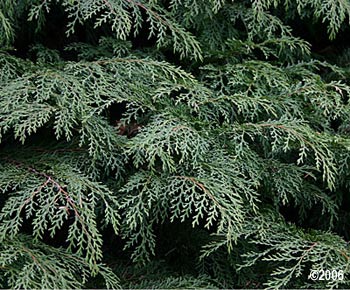 Microbiota is an under-appreciated genus of evergreen shrubs, the spreading types more valuable than junipers to gardeners witnessing the slow but sure march of shade across their properties, due to Microbiota’s sun-shy nature. Varieties of M. decussata flourish in part sun conditions, and will even grow broad and lush in dappled shade. ‘Northern Pride,’ the most common variety, features rich green, fine-textured foliage.
Microbiota is an under-appreciated genus of evergreen shrubs, the spreading types more valuable than junipers to gardeners witnessing the slow but sure march of shade across their properties, due to Microbiota’s sun-shy nature. Varieties of M. decussata flourish in part sun conditions, and will even grow broad and lush in dappled shade. ‘Northern Pride,’ the most common variety, features rich green, fine-textured foliage.
‘Drew’s Blue’ offers a new twist, bluish-green foliage that draws the eye more readily than the splendid ‘Northern Pride.’ This is a carpet-type evergreen, useful for planting at the base of trees and larger shrubs, and we should all enjoy stretches of carpet here and there across our landscapes that are something other than standard green. ‘Drew’s Blue’ is particularly well suited for the woodland garden.
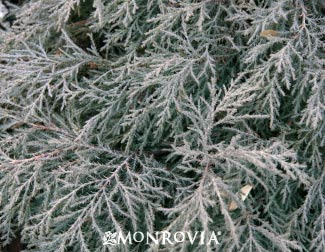 |
| Fall/winter foliage |
Plants mature between one and two feet tall, with a horizontal spread, in my experience, beyond what is listed in most catalogues (two to three feet). A mature spread of four to five feet can be expected, so plant in the correct spot the first time. As with ‘Northern Pride,’ ‘Drew’s Blue’ exhibits the neat trick of a fall foliage change to bronze, of particular winter interest in zones where snowfall does not completely cover the plant.
Plants are easy to care for and are deer-resistant. The only crucial requirement is that the soil be well drained; in clay soil, plants will soon succumb to crown rot. Provide ample moisture at time of planting, and provide regular watering to ensure that soil around plants does not dry out. Fertilize once in spring with an all-purpose, organic granular fertilizer.
Black Spot Award
Most Erroneous Advertising Claim: AzaGuard® Insect Control
 Once again, the names of two-dozen or so organic chemical gardening products making suspect claims in their advertising were placed in a hat, and a winner drawn at random. This year’s lucky winner is AzaGuard® Insecticide, manufactured by BioSafe Systems, LLC, East Hartford, Connecticut.
Once again, the names of two-dozen or so organic chemical gardening products making suspect claims in their advertising were placed in a hat, and a winner drawn at random. This year’s lucky winner is AzaGuard® Insecticide, manufactured by BioSafe Systems, LLC, East Hartford, Connecticut.
The advertising “fact” sheet for the product states:
AzaGuard is a non-toxic insecticide that repels insects on treated plants by inhibiting growth, feeding, and reproduction, resulting in a beautiful landscape and garden.
Hmm, let’s think for a minute…even though use of the word “repels” shows a deft touch, the fact remains that the product inhibits growth, feeding, and reproduction. Yup, that’ll kill an insect, alright, making this organic gardening product easily definable in one word: Toxic. (As are all organic chemical insecticides and herbicides.)
High Spot Award
Best Gardening Book of the Year: The Drunken Botanist
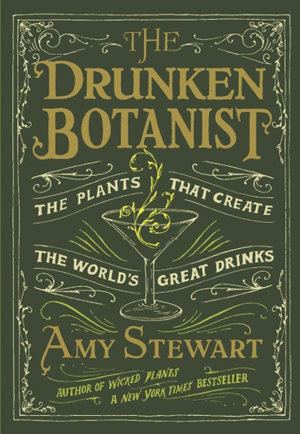 The astute, witty, and wholly charming garden writer Amy Stewart has written one of the most fascinating books about plants you’ll read, as in its pages you’ll travel across the British Isles and Europe to the Orient, from the forests of Africa to the jungles of South America, and in broad swaths across our own continent. It is the highly researched, page-turning concoction of biology, chemistry, history, etymology and mixology pursuant to the creation of alcoholic beverages through the ages to the present that make this book, a New York Times bestseller, such an addictive read.
The astute, witty, and wholly charming garden writer Amy Stewart has written one of the most fascinating books about plants you’ll read, as in its pages you’ll travel across the British Isles and Europe to the Orient, from the forests of Africa to the jungles of South America, and in broad swaths across our own continent. It is the highly researched, page-turning concoction of biology, chemistry, history, etymology and mixology pursuant to the creation of alcoholic beverages through the ages to the present that make this book, a New York Times bestseller, such an addictive read.
Stewart’s succinct, conversational writing is as smooth and quick-witted as everyone’s favorite guest at a summer cocktail party, as she deftly jiggers in intriguing side tales of the men and women, the governments and nations, the distilleries and moonshiners who have played pivotal roles in the evolution of the world of spirits. Most important, you’ll gain unique appreciation for a huge assortment of plants, for they are, after all, the straws that stir the drinks.
Available wherever books are sold, you may also purchase the book, signed by the author, by visiting Ms. Stewart’s site, Drunken Botanist.
Black Spot Award
Biggest Bummer: The Closing of Ambergate Gardens
That one of America’s best perennial nurseries was located twelve miles from my home and closed for good at the end of the 2013 gardening season wasn’t just a bummer for me and other area gardeners. Over its 28-year history, Ambergate had developed a large mail order business, supplying distinctive perennials to gardeners across North America.
I bought my first perennial at Ambergate, the first year they were open – Baptisia australis. I think it’s safe to say Ambergate was the only nursery in the Twin Cities selling it. That was the thing about Ambergate: Mike was such a perennial nut, he grew and sold hundreds of fabulous perennials not found at other nurseries, making Ambergate one of the first true “specialty” nurseries in America.
I remember a few decades ago when my editor at Better Homes and Gardens had flown into town, and after touring Twin Cities gardens, we had a few hours to kill before I took him to the airport. His request? “I’d like to check out Ambergate Gardens.” So we did, where he purchased three unusual perennials that he wrapped in newspaper and stuffed into his luggage.
At least it’s not a sad story – bad economy, dwindling sales, going broke, etc. The owners, nationally know perennial expert Mike Heger and his wife, Jean, simply decided it was time to retire. They had wisely purchased some 40 acres of prime farmland just outside the Twin Cities metro decades ago, a portion of which housed the funky Ambergate Gardens retail operation. A wise investment, they sold it to a developer.
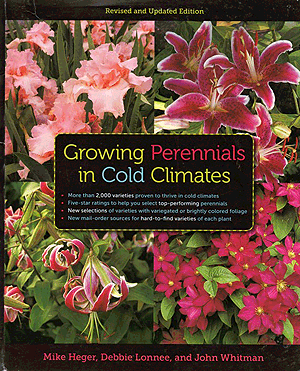 As they stated in their press release announcing the closing, “We are not totally retiring from horticulture. We have not been able to seriously garden for the last twenty-five years, so that’s first on the list. Mike plans to spend more time lecturing, writing and consulting. We plan to do some traveling to see gardens and other wonders of nature. In addition, our first grandchild is due this fall so we will undoubtedly be doing some babysitting.”
As they stated in their press release announcing the closing, “We are not totally retiring from horticulture. We have not been able to seriously garden for the last twenty-five years, so that’s first on the list. Mike plans to spend more time lecturing, writing and consulting. We plan to do some traveling to see gardens and other wonders of nature. In addition, our first grandchild is due this fall so we will undoubtedly be doing some babysitting.”
Mike is the principal author of the northern gardening perennial Bible, Growing Perennials in Cold Climates, recently updated and now for sale in affordable paperback. If you would like to keep abreast of the Heger’s activities, you can sign up for their e-mail newsletter by visiting www.ambergategardens.com.
Best wishes, Mike and Jean, I look forward to bumping into you down the road!
High Spot Award
Best Gardening Product of the Year: Grafted Vegetables
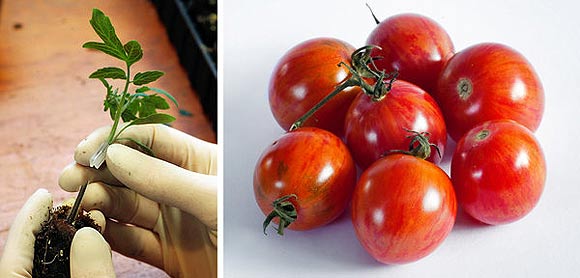
Coming very soon to every nursery near you: grafted vegetables, including a wide selection of heirloom tomato varieties (yes, I realize tomatoes are a fruit). Grafting – the process whereby a detached shoot or twig (a scion) containing buds from a food-producing plant is attached and grown into beefy, hardy rootstock – is being heralded as the most important development in vegetable growing since the earliest discoveries of organic fertilizers.
Already a thriving industry in Europe and Australia, U.S. growers are coming a bit late to the game – one billion vegetables were grafted worldwide in 2011, but hardly any in the U.S. But American growers should soon catch up; Log House Plants supplied its first grafted vegetables to 50 West Coast retailers in spring of 2010, and sold 40,000 plants. In 2013, they sold over one million.
The advantages of grafting are many. Scions from vegetables such as eggplants and peppers can be grafted onto rootstock from a different, perhaps less desirable variety, that happens to grow a larger root mass. After grafting, the new plants show a definite increase in yield. Grafting is also used to create disease-resistant fruits and vegetables, as well as expand the growing zone of the plants, as the traits from the plant root mass are passed onto the above-ground portion.
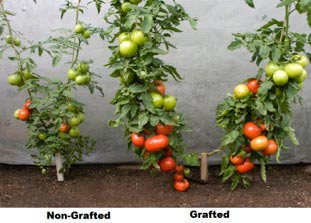 A great deal of grafting is being performed on tomatoes, particularly heirloom varieties, creating plants with higher yields and increased disease resistance. Andrew Mefferd, a crop tester for Johnny’s selected Seeds, notes, “We’ve seen a 30 to 50 percent boost in yield without any decrease in flavor. The fruits look the same, you just get more of them.”
A great deal of grafting is being performed on tomatoes, particularly heirloom varieties, creating plants with higher yields and increased disease resistance. Andrew Mefferd, a crop tester for Johnny’s selected Seeds, notes, “We’ve seen a 30 to 50 percent boost in yield without any decrease in flavor. The fruits look the same, you just get more of them.”
There is environmental benefit as well. As reported in an article in the May 29, 2013 issue of The New York Times extolling the virtues of grafted tomatoes:
The greater root mass of these grafted plants draws more water and nutrients from the soil, so they need less irrigation and fertilizing. And because they are resistant to many pests and diseases, grafted tomatoes have helped farmers worldwide to greatly reduce the use of methyl bromide, a gas used to fumigate soil pests that depletes the stratospheric ozone layer.
Reduction in chemical use – greater yields – healthier for the ozone layer. It’s another feather in the cap for agricultural scientist and nursery growers worldwide, and their heroic, ongoing quest to provide safe, affordable food for the planet. Just don’t spoil it all by revealing a wee little secret:
German scientists Sandra Stegemann and Ralph Brock from the Max-Planck Institute did gene analysis of grafted plants in 2009 and discovered that cells at the point of fusion were swapping genes like mad, with these altered cells merging into the entire plant. Their research shows that contrary to popular belief, grafted plants aren’t genetically distinct. Dubbed “Unintentional Genetic Engineering,” the scientists point out that their discovery “further blurs the boundary between natural gene transfer and genetic engineering.”
If it’s true that gene altering is taking place in the above ground portion of the plant from human intervention, then by definition, all these grafted plants are GMOs. It appears they may even swerve into genetic engineering territory within the GMO definition. Not that it’s any scary deal. Still, please keep this information under your hat! Grafted vegetables are well on their way to becoming the Next Big Thing in American grocery stores, farmers markets, and vegetable gardens, and we all know it doesn’t take much for some people to wig out when it comes to their food. What they don’t know won’t hurt them.
Black Spot Award
Worst Gardening Product of the Year: Preformed Plastic Waterfalls
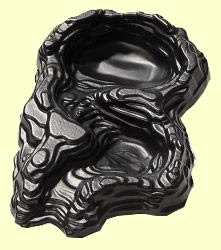 Though by no means new to the gardening scene in 2013, the escalating, incessant, zombie-like march of preformed plastic waterfalls across America has reached the point where it merits serious attention. A crisp bullet to the headwaters of these products is my recommendation.
Though by no means new to the gardening scene in 2013, the escalating, incessant, zombie-like march of preformed plastic waterfalls across America has reached the point where it merits serious attention. A crisp bullet to the headwaters of these products is my recommendation.
What is the principal aesthetic goal when creating a landscape? To showcase the beauty of nature, to dazzle and delight the senses, to create living, growing paintings, sculptures really, emulating and evoking each gardener’s individual creative interpretation of the natural world, to wrest sanity from insanity, health from decay, and to choose, once and for all, between lifelong adherence to the practical yet limiting teachings of Greek philosopher Epicurus, or the risky musings on intangibles of French philosopher Descartes.
That’s why I create landscapes, anyway. That and I get paid.
 Then along come plastic waterfalls, another demonic garden product that will lower real estate values in a trailer park. How could such a product come into being? Because they’re SIMPLE – EASY – FOOLPROOF. Meaning, of course, that upon installation, they look like hell. What’s most infuriating is that many of these faux waterfalls are being manufactured in England, of all places. I guess American global influence is something to worry about.
Then along come plastic waterfalls, another demonic garden product that will lower real estate values in a trailer park. How could such a product come into being? Because they’re SIMPLE – EASY – FOOLPROOF. Meaning, of course, that upon installation, they look like hell. What’s most infuriating is that many of these faux waterfalls are being manufactured in England, of all places. I guess American global influence is something to worry about.
If you want a waterfall, build a waterfall. They’re fun. You buy rubber pond liner and underlayment fabric, gravel, stone, a pump and hose, perhaps a filter basin, you go online and get 65 pages of mainly accurate drawings and instructions on how to build the thing. Once the materials are on site, you can build a small-to-medium stone waterfall in a weekend.
When you’re done, you have another glorious feature in your landscape that is unique to planet Earth, a joyous, soothing sculpture enriching the souls of all who gaze upon it, and hear its enchanting call – instead of a pathetic, polypropylene pond prosthesis.

Well glory be, that concludes this year’s Renegade Gardener High Spot/Black Spot Awards! Finish up your coffee and bacon cheesecake, the buses have arrived to whisk us away to the museum. See you all next year!
Don Engebretson
The Renegade Gardener
- The 2018 Renegade Gardener High Spot/Black Spot Awards January 5, 2019
- The 2017 Renegade Gardener High Spot/Black Spot Awards January 1, 2018
- The 2016 Renegade Gardener High Spot/Black Spot Awards January 1, 2017
- The 2015 Renegade Gardener High Spot/Black Spot Awards January 1, 2016
- The 2014 Renegade Gardener High Spot/Black Spot Awards January 7, 2015
- The 2013 Renegade Gardener High Spot/Black Spot Awards January 1, 2014
- The 2012 Renegade Gardener High Spot/Black Spot Awards January 4, 2013
- The 2011 Renegade Gardener High Spot/Black Spot Awards January 1, 2012
- The 2010 Renegade Gardener High Spot/Black Spot Awards January 1, 2011
- The 2009 Renegade Gardener High Spot/Black Spot Awards January 1, 2010
- The 2008 Renegade Gardener High Spot/Black Spot Awards January 1, 2009
- The 2007 Renegade Gardener High Spot/Black Spot Awards January 3, 2008
- The 2006 Renegade Gardener High Spot/Black Spot Awards December 20, 2006
- The 2005 Renegade Gardener High Spot/Black Spot Awards December 9, 2005
- The 2004 Renegade Gardener High Spot/Black Spot Awards January 1, 2005
- The 2003 Renegade Gardener High Spot/Black Spot Awards November 19, 2003
- The 2002 Renegade Gardener High Spot/Black Spot Awards October 31, 2002
- The 2001 Renegade Gardener High Spot/Black Spot Awards October 16, 2001
- The 2000 Renegade Gardener High Spot/Black Spot Awards October 20, 2000